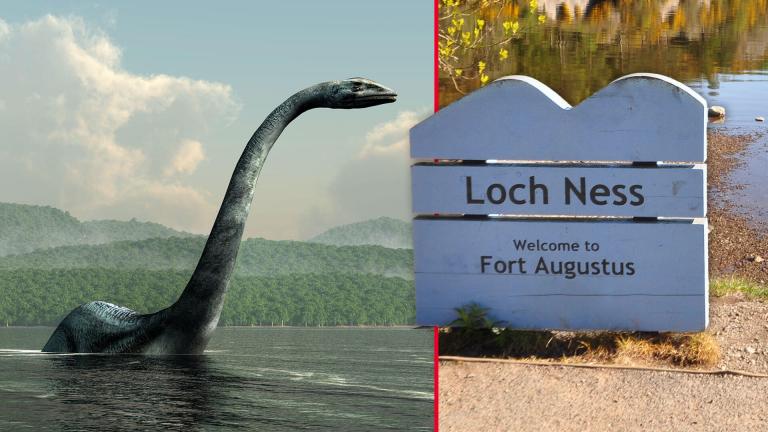
Read more about Mysteries

Rumours, myths and tall tales have long swirled around the vast Loch Ness in the Scottish Highlands. Most recently, a team of British scientists concluded that the existence of the Loch Ness Monster is 'plausible' after plesiosaur fossils were found in the Sahara Desert. The prehistoric reptiles were originally thought to have lived in saltwater, but this latest discovery indicates that they may have lived in freshwater. As plesiosaur fossils inspired reconstructions of the Loch Ness Monster, it is now entirely possible that one may have survived in a large, freshwater loch in the Scottish Highlands.
But what’s the real, verifiable history of the legend?
It might be surprising to learn that ‘Nessie’ is a relatively recent addition to world folklore, only really entering public consciousness in the 1930s. Of course, it did have its predecessors. Back in 1848, for example, the captain of the Royal Navy’s HMS Daedalus reported seeing ‘enormous serpent’ in the South Atlantic – a story which became a big media talking point of the time.
But Nessie wasn’t just a one-off, flash-in-the-pan sensation. Numerous eyewitness accounts have bolstered the legend, to make even hardened cynics wonder if there really is something prehistoric and terrifying in the depths of the loch. The article which opened the floodgates was published in the Inverness Courier in May 1933, reporting on a local couple, the Mackays, who spotted something very strange while driving by the loch. According to the article, the Mackays ‘were started to see a tremendous upheaval on the loch’, and then a whale-like creature which ‘disappeared in a boiling mass of foam’.
Another writer, Rupert Gould, later interviewed the Mackays and gleaned some tantalizing details about the beast. The couple described seeing ‘two black humps’ in the lake – a description which helped fix the classic image of Nessie in popular culture.
A few months after the article in the Courier, the same paper published another report, this time by a visitor to the area called George Spicer, and his story was even more startling. According to Spicer, he and his wife were driving by the loch when his car almost collided with ‘the nearest approach to a dragon or prehistoric animal that I have ever seen in my life’. Lumbering across the road, the creature had a ‘long neck’ and held a ‘small lamb or animal of some kind’ in its mouth. Rupert Gould interviewed Spicer too, getting more details such as its colour (‘a loathsome-looking greyish colour, like a dirty elephant’) and its odd physical form (‘the whole looked like a huge snail with a long neck’).
These early accounts established the most common view of Nessie as some kind of dinosaur-like throwback. They also inspired a certain Mr D. Mackenzie to write to Rupert Gould, alleging that he’d spotted something odd in the loch way back in 1871 or 1872 (he couldn’t remember exactly). Mackenzie’s rather grotesque description was of a creature that was ‘wriggling and churning up the water’ at great speed. ‘I have told this same story to my friends long before the ‘monster’ became famous,’ Mackenzie wrote.
It was also in 1933 that the first photograph of the Monster came to light. It was taken by a man called Hugh Gray, who was taking a walk by the loch when he saw ‘an object of considerable dimensions’ emerge from the water. His photograph has never attained iconic status, despite being the first alleged portrait of Nessie, probably because of how blurry and ambiguous it is (many have suggested it’s actually a photo of a dog swimming with a stick in its mouth). By contrast, the so-called ‘Surgeon’s Photograph’ of 1934 is still the most famous and defining image of the Monster, even though it’s been conclusively proved to be a fake.
The story went that a doctor called Robert Kenneth Wilson took the famous photo of the creature’s head and neck emerging from the loch. Many decades later, it was revealed that the whole episode was an elaborate, vengeful hoax perpetrated by Marmaduke Wetherell, an actor and filmmaker. Wetherell had previously been humiliated in the public eye after publicising apparent Monster footprints by the loch, which researchers then proved had been made using a preserved hippo’s foot – popularly used as umbrella stands and ashtrays at the time. Shamed by the fall out, Wetherell and some friends decided to get their own back by orchestrating the Surgeon’s Photograph, using a tricked-up toy submarine.
Since then, there have been multiple investigations of the loch – no easy thing, since it contains more water than all the rivers and lakes in England and Wales put together. Sonar readings have been inconclusive, giving the public free rein to fantasise about plesiosaurs and other flamboyant creatures in the loch. In September 2019, New Zealand scientists analysed DNA in the water, ruling out large marine reptiles, sturgeon or sharks. One of the team, Professor Neil Gemmell, did speculate about another candidate:
‘There is a very significant amount of eel DNA,’ he said in an interview with the BBC, before going on to say: ‘The sheer quantity of the material says that we can't discount the possibility that there may be giant eels in Loch Ness. Therefore we can't discount the possibility that what people see and believe is the Loch Ness Monster might be a giant eel.’
One thing’s for certain: we can expect the theories, rumours and competing mythologies of Loch Ness to continue for generations to come.